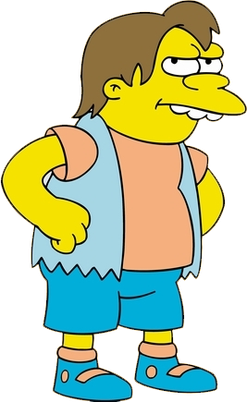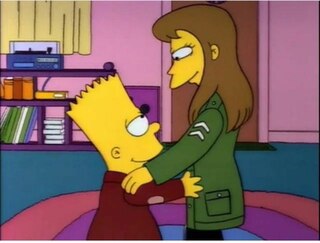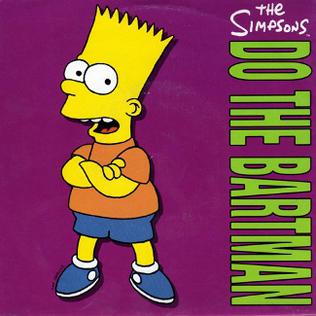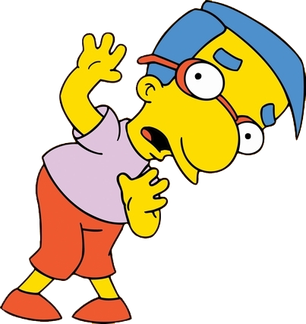
Bartholomew Jojo "Bart" Simpson is a fictional character in the American animated television series The Simpsons and part of the Simpson family. He is voiced by Nancy Cartwright and first appeared on television in The Tracey Ullman Show short "Good Night" on April 19, 1987. Cartoonist Matt Groening created and designed Bart while waiting in the lobby of James L. Brooks' office. Groening had been called to pitch a series of shorts based on his comic strip, Life in Hell, but instead decided to create a new set of characters. While the rest of the characters were named after Groening's family members, Bart's name is an anagram of the word brat. After appearing on The Tracey Ullman Show for two years, the Simpson family received its own series on Fox, which debuted December 17, 1989. Bart has appeared in every Simpsons episode except "Four Great Women and a Manicure".

Nelson Mandela Muntz is a fictional character and the lead school bully from the animated television series The Simpsons, where he is best known for his signature mocking laugh "Ha-ha!". He is voiced by Nancy Cartwright. Nelson was first introduced in Season 1's "Bart the General" as an antagonist, but later became more of an anti-hero, continuing to bully those weaker than him while occasionally showing a friendly and sensitive nature underneath. Nelson lives in poverty with his mother in a run-down home, and often shoplifts from convenience stores to get by.

Kirby's Adventure is a 1993 platform game developed by HAL Laboratory and published by Nintendo for the Nintendo Entertainment System (NES). It is the second game in the Kirby series after Kirby's Dream Land (1992) on the Game Boy and the first to include the Copy Ability, which allows the main character Kirby to gain new powers by eating certain enemies. The game centers around Kirby traveling across Dream Land to repair the Star Rod after King Dedede breaks it apart and gives the pieces to his minions.

The Simpsons Sing the Blues is the first album released as an offshoot of The Simpsons. The album contains originally recorded music not featured in the series save for the first verse of the track "Moaning Lisa Blues" which was first featured in the episode "Moaning Lisa", which aired in the United States on February 11, 1990. The album was released on December 4, 1990, and peaked at No. 3 on the Billboard 200.
"The Telltale Head" is the eighth episode of the American animated television series The Simpsons. It originally aired on the Fox network in the United States on February 25, 1990. It was written by Al Jean, Mike Reiss, Sam Simon and Matt Groening, and directed by Rich Moore. In the episode, Bart cuts the head off the statue of Jebediah Springfield in the center of town to impress Jimbo, Kearney and Dolph, three older kids he admires. The town's residents, including the three boys, are horrified and Bart regrets his actions. After telling Lisa and Marge, Homer and Bart head to the center of town, where they are met by an angry mob. After Bart tells the mob that he has made a mistake, the townspeople forgive Bart and the boy places the head back on the statue. The episode's title is a reference to the 1843 short story "The Tell-Tale Heart" by Edgar Allan Poe.
"Kamp Krusty" is the fourth season premiere of the American animated television series The Simpsons, and the 60th episode overall. It originally aired on the Fox network in the United States on September 24, 1992. In the episode, the children of Springfield attend Kamp Krusty, a summer camp named after Krusty the Clown. The camp is extremely unpleasant, leading to the campers rebelling against the camp director. Meanwhile, with the kids away, Homer and Marge enjoy more time together, and Homer becomes physically and emotionally healthier.

The Simpsons is an arcade beat 'em up developed and published by Konami released in 1991. It was the first video game based on the Simpsons franchise to be released in North America. The game allows up to four players to control members of the Simpson family as they fight various enemies to rescue the kidnapped Maggie. It was a commercial success in the United States, where it was one of the top three best-selling arcade video game machines of 1991, The game also features the television shows's voice actors; Dan Castellaneta, Julie Kavner, Nancy Cartwright and Yeardley Smith reprising their respective roles as the Simpsons family.

"Lisa's First Word" is the tenth episode of the fourth season of the American animated television series The Simpsons. It was first broadcast on the Fox network in the United States on December 3, 1992. In the episode, as the Simpson family gathers around Maggie and tries to encourage her to say her first word, Marge reminisces and tells the story of Lisa's first word. Maggie's first word is voiced by Elizabeth Taylor.

"New Kid on the Block" is the eighth episode of the fourth season of the American animated television series The Simpsons. It originally aired on the Fox network in the United States on November 12, 1992. After meeting his new neighbor, Laura, Bart falls in love with her, only to later discover that she has a boyfriend, Jimbo Jones, whom he attempts to scare off so that he can have a relationship with Laura. Meanwhile, Homer sues the Sea Captain Horatio McCallister after being kicked out of his all-you-can-eat restaurant while still hungry.

The Simpsons: Bart vs. the Space Mutants is a platform video game, the second based on the animated television series The Simpsons. It was released in 1991 for the Nintendo Entertainment System, Amiga, Amstrad CPC, Atari ST, Commodore 64, and ZX Spectrum, and in 1992 for Sega Genesis, Master System and Game Gear. It was published by Acclaim Entertainment on consoles and Ocean Software on computers, and developed by Imagineering and Arc Developments. In the game, the player controls Bart Simpson through five levels as he tries to ruin the aliens' plan to take over the world. Video game critics have given Bart vs. the Space Mutants mixed reviews, with criticism directed at the difficulty of the game, partly caused by restricted controls.

Virtual Bart is a video game developed by Sculptured Software and published by Acclaim Entertainment. It was released for the Super NES and Genesis in 1994. It is a game based on the American animated television series The Simpsons and features Bart Simpson and other Simpsons characters.

The Simpsons: Bartman Meets Radioactive Man is a 1992 platform game published by Acclaim for the Nintendo Entertainment System and Game Gear. Developed by Imagineering, the side-scrolling game features Bart Simpson on a comic book quest to rescue his kidnapped idol, superhero Radioactive Man. Bartman Meets Radioactive Man received generally negative reviews from critics, with criticism being directed at the gameplay control.

"Do the Bartman" is a song from the 1990 album The Simpsons Sing the Blues, featuring the voice cast of the American animated television series The Simpsons. It was performed by The Simpsons cast member Nancy Cartwright, with backing vocals from American singer Michael Jackson, alongside additional vocals from Dan Castellaneta. Jackson also produced the song, which was written by American recording artist Bryan Loren, and Geffen Records released it as a single on November 20, 1990.

"Deep, Deep Trouble" is a rap song from the 1990 Simpsons album The Simpsons Sing the Blues, performed by the fictional character Bart Simpson about his trouble-making antics. It was written by Matt Groening and DJ Jazzy Jeff and recorded in September 1990.

The Simpsons Game is a 2007 platform game based on the animated television series The Simpsons made for the Nintendo DS, Wii, Xbox 360, PlayStation 2, PlayStation 3 and PlayStation Portable. The game was published and distributed by Electronic Arts. It was released in North America in October 2007 and worldwide in November 2007, a few months after The Simpsons Movie. It features an original storyline, not related to the movie, written by Simpsons writers Tim Long and Matt Warburton. In the self-referential plot, the family discovers that they are forced to participate in another The Simpsons video game. Similar to the show, the game pokes fun at popular culture, many other video games, and Electronic Arts, its publisher.

Dean Rankine is an Australian comics artist, writer and illustrator. Rankine's work has appeared in many comics, books and magazines.

Milhouse Mussolini Van Houten is a recurring character in the Fox animated television series The Simpsons voiced by Pamela Hayden and created by Matt Groening. Milhouse is Bart Simpson's best friend in Mrs. Krabappel's fourth grade class at Springfield Elementary School. He is insecure, gullible, and is often led into trouble by Bart, who takes advantage of his friend's naïveté. Milhouse is a regular target for school bully Nelson Muntz and his friends Jimbo Jones, Dolph Starbeam and Kearney Zzyzwicz. He has an unrequited crush on Bart's sister, Lisa, which is a common plot element.
"Beware My Cheating Bart" is the eighteenth episode of the twenty-third season of the American animated television series The Simpsons. The episode was directed by Mark Kirkland and written by Ben Joseph. It originally aired on the Fox network in the United States on April 15, 2012. The title refers to the song "Be Still My Beating Heart" by Sting.














